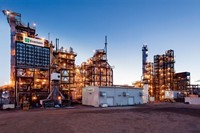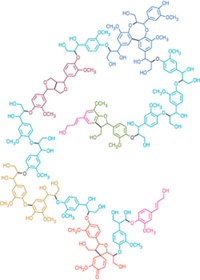Advertisement
Grab your lab coat. Let's get started
Welcome!
Welcome!
Create an account below to get 6 C&EN articles per month, receive newsletters and more - all free.
It seems this is your first time logging in online. Please enter the following information to continue.
As an ACS member you automatically get access to this site. All we need is few more details to create your reading experience.
Not you? Sign in with a different account.
Not you? Sign in with a different account.
ERROR 1
ERROR 1
ERROR 2
ERROR 2
ERROR 2
ERROR 2
ERROR 2
Password and Confirm password must match.
If you have an ACS member number, please enter it here so we can link this account to your membership. (optional)
ERROR 2
ACS values your privacy. By submitting your information, you are gaining access to C&EN and subscribing to our weekly newsletter. We use the information you provide to make your reading experience better, and we will never sell your data to third party members.
Business
Firms Glean The Rice Harvest For Silica
Companies aim to extract the tire additive from a little known source
by Alexander H. Tullo
December 1, 2014
| A version of this story appeared in
Volume 92, Issue 48
Next year, Goodyear Tire & Rubber will begin tapping into rice as a source of raw materials for its tires. But this effort has nothing to do with the company’s program to make key organic tire ingredients such as isoprene from carbohydrates.

This time, Goodyear is extracting an inorganic chemical, silica, which it will use as an environmentally friendly alternative to the sand-derived precipitated silica it now blends into its rubber to enhance traction and fuel economy. The new silica will come from ash left over after rice hulls are burned in electric power plants.
Rice hulls are a potent source of silica. Depending on how they are burned, their ash can contain more than 90% SiO2. According to Surendra Chawla, senior director of external science and technology programs for Goodyear, the world’s 700 million-ton annual rice crop can yield up to 25 million tons of silica. This is more than 30 times the amount of precipitated silica used in tires annually.
Goodyear isn’t the only company eyeing this source. Italian high-performance tire maker Pirelli already uses silica from rice hull ash at its plant in Brazil. Additionally, start-up companies such as Mayaterials are pursuing the production of silica and other molecules from rice hull ash.
Rice hull silica also isn’t new to Tom Spies, chief operating officer of the Powell Group. His company operates Farmers Rice Milling in Lake Charles, La., which processes about 420,000 tons of locally grown rice annually. The rice hulls from Farmers are conveyed pneumatically to another Powell operation, Agrilectric Power, which burns them to generate 12 MW of electricity.
“We probably market and sell more rice hull ash than anybody else in the world,” Spies says, about 17,000 tons per year.
Agrilectric’s suspension burn process makes for rice hull ash that is 92% amorphous silica, a high-quality grade. The fluidized-bed incinerators other companies use burn the hulls unevenly and yield more crystalline silica and carbon. Such material is usually landfilled, Spies says.
The steel industry is the largest buyer of Agrilectric’s ash. Steel mills dump the ash on top of ladles of molten steel to retain heat. Agrilectric also sells the ash as an adsorbent, for water filtration, and as an amendment to help soil retain water and fertilizer.
Richard M. Laine, a professor of materials science and engineering at the University of Michigan and founder of Ann Arbor-based Mayaterials, has been applying chemistry to rice hull ash to make silica-containing compounds.
For example, Laine reacts the silica in the ash with tetramethyl ammonium hydroxide, a semiconductor silicon etchant, to form silsesquioxanes. These nanoscale silica cages can be functionalized with organic compounds for use in coatings, composites, and other materials.
Mayaterials also has been developing a process for making high-purity silica in which rice hull ash is dissolved in ethylene glycol and small, catalytic quantities of sodium hydroxide. The glycol reacts with the silica to form an alkoxysilane. Impurities such as the carbon residue are filtered out, and the silica is precipitated with water.
Laine claims environmental benefits over the conventional process for making silica. In it, silica sand is reacted with sodium carbonate to form sodium silicate. Amorphous silica is precipitated out of the silicate solution with sulfuric acid. The process gives off by-products such as carbon dioxide and sodium sulfate. And, according to Laine, it runs at about 1,300 °C, versus only 200 °C for his process.
Silica sand can be dissolved in ethylene glycol, too, Laine says. But the high surface area of the rice hull silica—about 80 m2/g as opposed to 1 m2/g for silica sand—allows the treatment to be done fast enough for industrial use.
C&EN contacted three major producers of conventional silica—Evonik Industries, PPG Industries, and Solvay—for their views on competition from rice hull silica. None commented.
But they might be alarmed at Goodyear’s efforts. Goodyear was inspired to pursue rice after seeing Mayaterials’s presentation at a Small Business Innovation Research conference several years ago.
The firm initially worked with Mayaterials but later opted to partner with Chinese and Indian universities and rice millers. Chawla won’t give many details about Goodyear’s preparation process, though he does say it avoids the high temperature and by-products of the conventional method.
Chawla, who oversaw road testing of the tires, says researchers have brought silica properties such as the particle size and porosity up to Goodyear’s exacting standards. “It took us two or three years to fine-tune the process so that the silica that is extracted is of a high quality that can be used in tires,” he says.
A rice mill outside the U.S. is running a pilot plant for Goodyear, and the silica will be used in a line of tires to be announced next year.
To Chawla, rice hull silica is a win-win. His company is diverting a waste material from the landfill and adding value to it with little energy. There is no catch, not even the food versus fuel controversy that dogs many biobased chemical processes. “I am not taking corn away from any mouths,” he says.




Join the conversation
Contact the reporter
Submit a Letter to the Editor for publication
Engage with us on Twitter